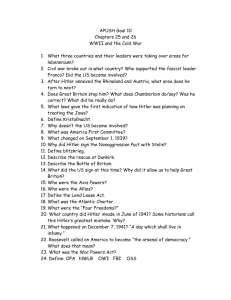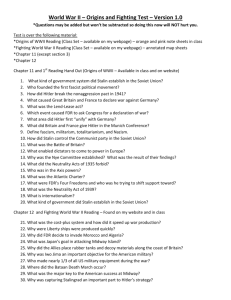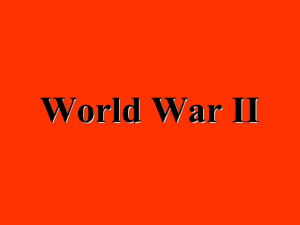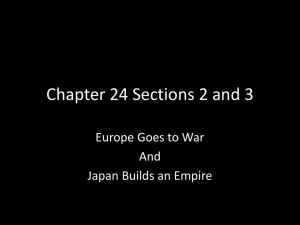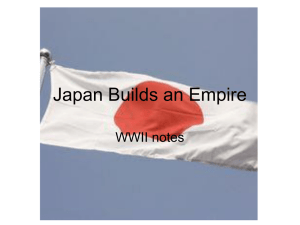Chapter 17 WS - Dr. Larson
advertisement
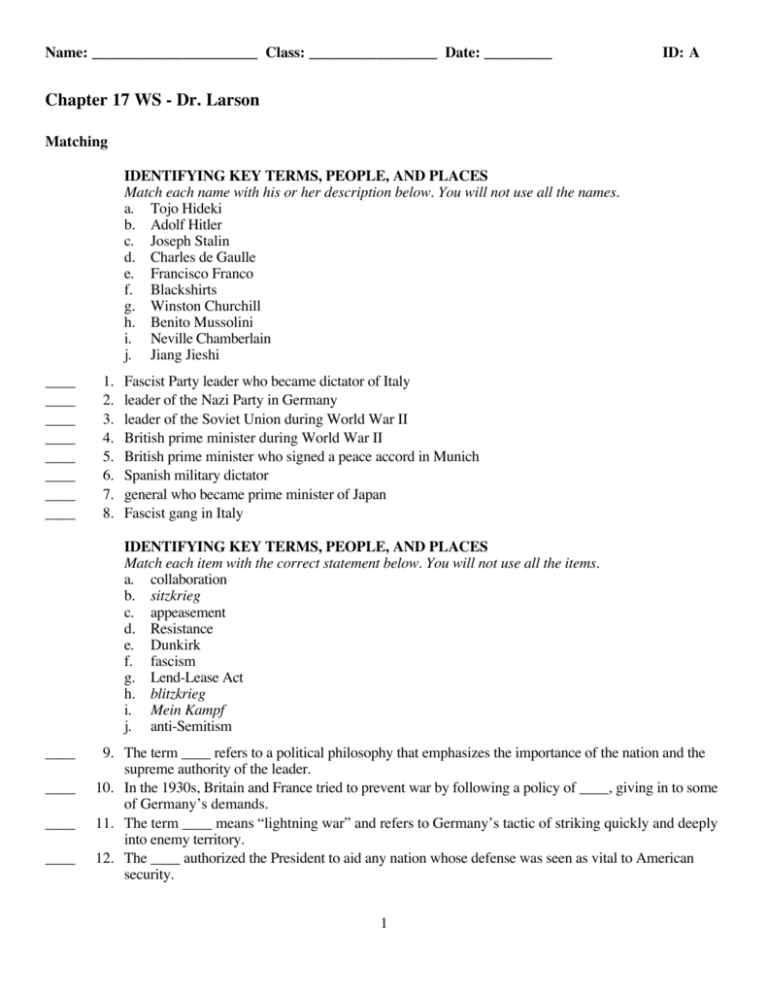
Name: ______________________ Class: _________________ Date: _________ ID: A Chapter 17 WS - Dr. Larson Matching IDENTIFYING KEY TERMS, PEOPLE, AND PLACES Match each name with his or her description below. You will not use all the names. a. Tojo Hideki b. Adolf Hitler c. Joseph Stalin d. Charles de Gaulle e. Francisco Franco f. Blackshirts g. Winston Churchill h. Benito Mussolini i. Neville Chamberlain j. Jiang Jieshi ____ ____ ____ ____ ____ ____ ____ ____ 1. 2. 3. 4. 5. 6. 7. 8. Fascist Party leader who became dictator of Italy leader of the Nazi Party in Germany leader of the Soviet Union during World War II British prime minister during World War II British prime minister who signed a peace accord in Munich Spanish military dictator general who became prime minister of Japan Fascist gang in Italy IDENTIFYING KEY TERMS, PEOPLE, AND PLACES Match each item with the correct statement below. You will not use all the items. a. collaboration b. sitzkrieg c. appeasement d. Resistance e. Dunkirk f. fascism g. Lend-Lease Act h. blitzkrieg i. Mein Kampf j. anti-Semitism ____ ____ ____ ____ 9. The term ____ refers to a political philosophy that emphasizes the importance of the nation and the supreme authority of the leader. 10. In the 1930s, Britain and France tried to prevent war by following a policy of ____, giving in to some of Germany’s demands. 11. The term ____ means “lightning war” and refers to Germany’s tactic of striking quickly and deeply into enemy territory. 12. The ____ authorized the President to aid any nation whose defense was seen as vital to American security. 1 Name: ______________________ ____ ____ ____ ____ 13. 14. 15. 16. ID: A Vichy France adopted a policy of ____ with Germany. The Free French backed the underground ____ movement. At ____, British and Frence vessels rescued Allied soldiers. ____ was the title of Hitler’s autobiography. KEY TERMS Match each term with its description below. a. fascism b. appeasement c. Axis Powers d. totalitarian ____ ____ ____ ____ 17. philosophy emphasizes the importance of the nation or an ethnic group and the supreme authority of the leader 18. government that exerts total control over a nation 19. keeping the peace by giving into an aggressor’s demands 20. Germany and Italy, later joined by Japan KEY TERMS Match each term with its description below. a. Resistance b. Allies c. collaboration d. blitzkrieg ____ ____ ____ ____ 21. 22. 23. 24. “lightning war” close cooperation the group of countries who opposed the Axis Powers French underground movement to oppose the Germans KEY TERMS Match each term with its description below. a. America First Committee b. cash and carry c. Lend-Lease Act d. Neutrality Acts ____ ____ ____ ____ 25. 26. 27. 28. act authorizing the President to aid any nations whose defense he felt was vital to American security U.S. laws designed to keep the nation out of future wars group of American isolationists policy that required countries at war to pay cash for all nonmilitary goods and provide transport 2 Name: ______________________ ID: A Multiple Choice Identify the letter of the choice that best completes the statement or answers the question. IDENTIFYING MAIN IDEAS ____ ____ ____ ____ ____ ____ ____ ____ 29. What did Italy, Germany, and Japan have in common in the 1930s? a. They overturned traditional governments and established democracies. b. They were economic giants and together controlled world trade. c. They sought to solve their nations’ problems through conquest. d. They angered other nations by their persecution of the Jews. 30. Which was part of American policy during the early years of World War II? a. denouncing Britain and France for declaring war on Germany b. following a foreign policy of appeasement c. remaining neutral while making war supplies available to Britain d. terminating all trade agreements with warring nations 31. What prompted the United States to enter the war in 1941? a. the imprisonment of Jews in German concentration camps b. the Japanese attack on Pearl Harbor c. the pact that the Soviet Union signed with Germany d. Germany’s invasion of the Rhineland 32. Joseph Stalin dominated the Soviet Union using the tactics of a. appeasement and neutrality. b. coaxing and persuasion. c. gifts of food and land. d. terror and purges. 33. Both Mussolini and Hitler saw expansion of their territory as a way to increase a. national pride. b. pressure on their neighbors. c. goodwill toward their neighbors. d. pressure on their enemies. 34. The Axis Powers were named for the “axis” between which two European capitals? a. London and Paris b. Paris and Berlin c. Berlin and Rome d. Berlin and Warsaw 35. Although Communists and Fascists have traditionally been enemies, in 1939 which Fascist made a pact with which Communist? a. Hitler with Chamberlin b. Hitler with Stalin c. Hitler with Franco d. Stalin with Franco 36. In 1932, Manchuria was taken over by a. Hitler and the Germans. b. Stalin and the Soviets. c. the Japanese military. d. Franco and the Nationalists. 3 Name: ______________________ ____ ____ ____ ____ ____ ____ ____ ____ ____ ID: A 37. The Burma Road was a 700-mile-long highway linking Burma (present-day Myanmar) to a. Vietnam. b. Thailand. c. the Soviet Union. d. China. 38. The Japanese leaders believed they could cripple the American naval fleet a. in the Dutch East Indies. b. in Manchuria. c. at Pearl Harbor. d. at Shanghai. 39. During the 1930s, Hitler, Mussolini, and the military leaders of Japan a. had a monopoly on world trade. b. began invading neighboring lands. c. organized the League of Nations. d. bolstered national pride by calling for free elections. 40. During the early years of World War II, the United States a. organized several peace talks between the Allies and the Axis powers. b. stopped trading with all nations at war. c. tried to remain neutral while supplying weapons to Britain and France. d. sent military and economic aid to all nations at war. 41. The Japanese attack on Pearl Harbor a. prompted the United States to enter the war. b. marked the final Japanese victory of the war. c. did not cause significant damage to American warships or planes. d. led directly to the liberation of the Philippines. 42. Stalin modernized agriculture in the Soviet Union through a. capitalism. b. nationalization. c. collectivization. d. socialization. 43. What was one result of the Manchurian Incident? a. It greatly increased power of the Japanese army over the government. b. It greatly increased power of Korea over China. c. It greatly increased confidence in the Chinese over Japan. d. It greatly lessened Japanese military control. 44. Lebensraum was the term Hitler used that meant a. a dream of German domination of all Europe. b. a dream of German domination of the Soviet Union. c. more power for Germany over Italy. d. more living space for the Germans. 45. After Hitler had invaded Czechoslovakia and made a pact with Stalin, he invaded a. Poland. b. France. c. England. d. Japan. 4 Name: ______________________ ____ ____ ____ ____ ____ ____ ____ ____ ____ ID: A 46. In 1940, one of the greatest rescues in the history of warfare occurred a. in Denmark and Norway. b. in the Netherlands. c. at the Maginot Line. d. at Dunkirk. 47. Great Britain held out against the German attack at the Battle of a. Dunkirk. b. Stalingrad. c. Britain. d. Paris. 48. The America First Committee wanted to a. enter the war. b. block any further aid to Britain. c. bomb Japan. d. attack Germany. 49. How did Mussolini use gangs of Fascist thugs in Italy? a. to guard Allied prisoners b. to invade Ethiopia c. to draw up new laws d. to terrorize his opponents 50. Which country had gained control of most of Western Europe by 1940? a. Italy b. Japan c. Germany d. Russia 51. In order to modernize agriculture in the Soviet Union, Joseph Stalin a. encouraged small farmers to buy modern farm equipment. b. provided state funds to small farmers for more modern equipment. c. demanded that all farmers raise their levels of production. d. combined small family farms into collective farms run by the state. 52. Nazism was an extreme form of a. communism. b. fascism. c. nationalism. d. none of the above 53. What historical event contributed to the rise of fascism in both Italy and Germany, and to the rise of totalitarianism in the Soviet Union? a. the Spanish Civil War b. the Russian Revolution c. the Nuremberg Party rally d. World War I 54. To which direction did Hitler look when he decided Germany needed more lebensraum (“living space”)? a. to the east: eastern Europe and the Soviet Union b. to the west: France and Spain c. to the south: Italy and Austria d. to the north: Denmark and Norway 5 Name: ______________________ ____ ____ ____ ____ ____ ____ ____ ____ ____ ID: A 55. Hitler signed a Nonaggression Pact with a. Britain. b. the Soviet Union. c. France. d. Poland. 56. Hitler used which of the following military strategies when invading Poland? a. a sitzkrieg b. the Maginot Line c. a blitzkrieg d. U-boat attack 57. Where did one of the greatest rescues in the history of warfare take place? a. Dunkirk b. Paris c. Warsaw d. London 58. The Vichy government of France adopted which of the following policies after Germany conquered France? a. resistance b. surrender c. appeasement d. collaboration 59. In what battle did Hitler launch the greatest air assault the world had yet seen? a. Battle of Paris b. Battle of Britain c. Battle of Dunkirk d. Battle of Stalingrad 60. Who inspired the British people to resist the German invasion? a. Charles de Gaulle b. Franklin D. Roosevelt c. Winston Churchill d. Jose Stalin 61. Who sailed into Tokyo Bay in 1853 to help force open Japanese trade to foreigners? a. P’u-I, Manchurian emperor b. Mao Zedong c. Matthew Perry d. Jiang Jieshi 62. By the beginning of World War I, Japan had a. been partly dominated by China. b. become a neutral country. c. become the strongest East Asian nation. d. encouraged Korean self-rule. 63. Which was the real motive behind the Greater East Asia Co-Prosperity Sphere? a. Japan wanted to liberate Asia from European colonizers. b. China wanted to expand its influence to the south. c. Japan, China, and Korea wanted to share their common natural resources. d. Japan wanted the region’s natural resources for its war against China. 6 Name: ______________________ ____ ____ ____ ____ ____ ____ ____ ____ ____ ID: A 64. What was Manchukuo? a. part of the Dutch East Indies b. a town along the Burma Road c. puppet state after Manchuria d. an important Japanese city 65. Why did two Chinese leaders, Jiang Jieshi and Mao Zedong, unite? a. to help form the Greater East Asia Co-Prosperity Sphere b. to fight the Japanese c. to defend the Burma Road d. to set up a puppet state in Manchuria 66. In September 1940, Japan allied itself with a. the Axis Powers. b. the Allies. c. the Chinese. d. the Dutch East Indies. 67. In the Manchurian Incident, the Japanese army a. acted on its own to overrun the whole of Manchuria. b. consulted with the Japanese government before entering Manchuria. c. was run out of Manchuria by the Chinese. d. made a pact with Russia in order to occupy Manchuria. 68. During the 1930s, the United States focused largely on a. preparing for war. b. domestic affairs. c. international affairs. d. international and domestic affairs. 69. Congress passed Neutrality Acts that were designed to a. support other neutral states around the world. b. support other nations in the Western Hemisphere. c. limit international involvement. d. allow nations to purchase weapons on credit. 70. A group of isolationists that included aviator Charles Lindbergh formed the a. Americans for Peace Committee. b. America First Committee. c. Neutrality Now League. d. American Anti-War League. 71. Which militant Japanese general became prime minister in October of 1941? a. Tojo Hideki b. Hirota Koki c. P’u-I d. Manchukuo 72. All of the following events led up to the Japanese attack on Pearl Harbor except a. Japanese forces took control of French Indochina. b. a group of isolationists formed to block aid to Britain. c. President Roosevelt froze Japanese financial assets in the United States. d. the Japanese looked to the Dutch East Indies for oil. 7 Name: ______________________ ____ ID: A 73. Shortly after Congress passed a war declaration on Japan, which other two countries declared war on the United States? a. Russia and Germany b. Russia and China c. Germany and China d. Italy and Germany Essay CRITICAL THINKING 74. Recognizing Cause and Effect What factors motivated Italian, German, and Japanese leaders to pursue aggressive foreign policies in the 1930s? 75. Demonstrating Reasoned Judgment Do you think the United States would have entered World War II if the Japanese had not attacked Pearl Harbor? Explain. 76. Making Comparisons What similar strategies did leaders in Germany, Italy, and Japan use to transform their nations into strong world powers? 77. Identifying Motivations What do you think might have been some of the events in Europe that motivated Japan to enter the war on the side of the Axis Powers? 8


